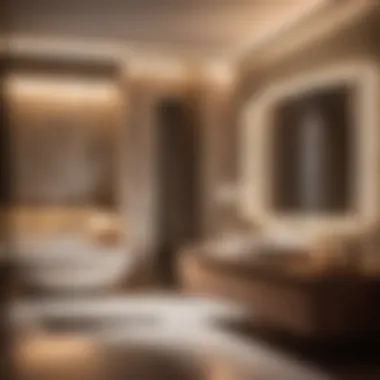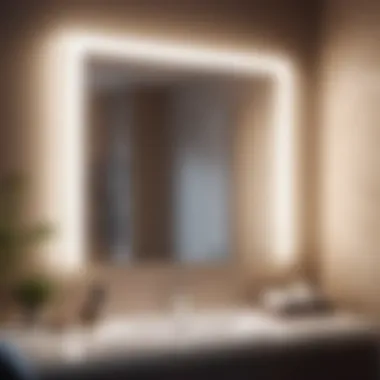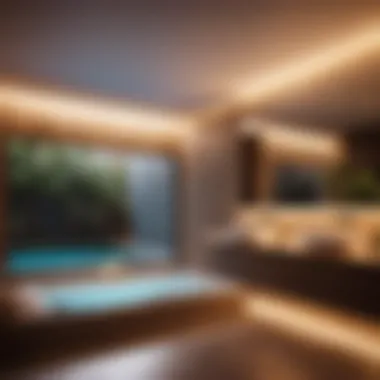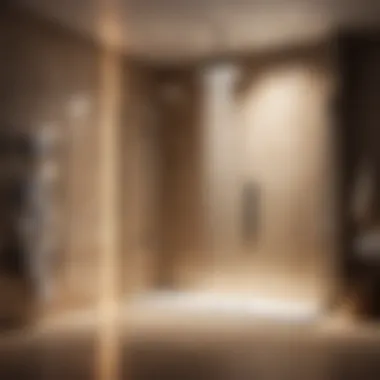Mastering Lumens: The Definitive Bathroom Lighting Guide


- Six recessed LED lights with a lumen output of 800 each
- Two vanity light fixtures with a lumen output of 1200 each
- One overhead LED light panel with a lumen output of 3000
diy steps:
- Begin by determining the total square footage of your bathroom space to calculate the required lumens for adequate illumination.
- Identify the areas where task lighting, ambient lighting, and accent lighting are necessary for optimal functionality and aesthetics.
- Select LED lights with the appropriate lumen output based on the size and layout of each lighting zone.
- Install recessed LED lights above the shower and toilet areas to provide focused task lighting with a lumen output of 800 each.
- Mount vanity light fixtures on either side of the bathroom mirror with a lumen output of 1200 each for flattering and functional lighting during daily routines.
- Attach an overhead LED light panel in the center of the ceiling with a lumen output of 3000 to ensure overall brightness and spacious feel.
technical aspects:
- Tools required: Screwdriver, wire stripper, voltage tester
- Timing specifics: Allocate 1-2 hours for light fixture installation and wiring
- Critical techniques: Ensure proper wiring connections and secure mounting for safety and longevity
diy project process:
- Start by turning off the power to the bathroom lighting circuit at the breaker box to avoid electrical accidents.
- Remove any existing light fixtures and prepare the wiring for the new LED lights by following manufacturer instructions.
- Install the recessed LED lights in the designated areas, making sure they are evenly spaced and aligned for uniform illumination.
- Wire the vanity light fixtures according to the wiring diagram provided, connecting them to a compatible dimmer switch for adjustable brightness.
- Position the overhead LED light panel securely on the ceiling, ensuring it is centered for balanced lighting distribution.
troubleshooting tips:
- If lights flicker or do not turn on, double-check the wiring connections and voltage to troubleshoot potential issues.
- Dimmer switches may require adjustment or compatibility verification with LED fixtures to function correctly.
- In case of uneven lighting patterns, reposition the fixtures to achieve desired illumination levels and coverage.
Introduction to Lumens in Bathroom Lighting
In the realm of bathroom lighting, understanding lumens is paramount to achieving the perfect ambiance and functionality. As we embark on this enlightening journey into the world of lumens, we will uncover the crucial role they play in illuminating our bathrooms effectively.
When we talk about lumens, we are delving into the measurement of brightness that a light source emits. It is not about the power consumption but rather the amount of light produced. This distinction is crucial as it directly impacts the overall visibility and atmosphere within your bathroom space. By grasping the concept of lumens, you gain the ability to tailor your lighting to suit specific needs and preferences.
Understanding Lumens
Lumens essentially quantify the total amount of visible light produced by a source, providing a reliable indicator of how bright a light will be. Unlike watts, which measure power consumption, lumens give a more accurate depiction of the actual light output your fixture will yield. This distinction is vital in ensuring that your bathroom is adequately illuminated, enhancing its practicality and aesthetics.
Benefits of Adequate Lumens in Bathroom Lighting
Adequate lumens in bathroom lighting bring a myriad of benefits beyond mere brightness. With optimal lumen levels, you can create a well-lit environment that promotes a sense of spaciousness and sophistication. Moreover, proper lighting can enhance safety by reducing shadows and ensuring visibility, especially in critical areas like the vanity or shower. By harnessing the power of lumens in your bathroom space, you can transform it into a welcoming sanctuary that caters to your every need.
Importance of Lumens


When it comes to creating the perfect ambiance and functionality in your bathroom, lumens play a crucial role. Lumens refer to the measurement of the total amount of visible light emitted by a light source. Understanding the importance of lumens in bathroom lighting is essential for achieving the right balance of brightness and energy efficiency.
Understanding Lumens
To grasp the significance of lumens in bathroom lighting, it's vital to comprehend how different lumen levels can impact the overall brightness of the space. By knowing the lumens required for various tasks within the bathroom, you can ensure adequate illumination for grooming, skincare routines, and relaxation.
Benefits of Adequate Lumens in Bathroom Lighting
Opting for appropriate lumens in your bathroom lighting offers numerous advantages. Firstly, proper lighting can enhance the overall aesthetics of your bathroom, making it feel more spacious and inviting. Adequate lumens also contribute to a safer environment by reducing the risk of accidents, especially in areas like the shower or around slippery surfaces. Moreover, well-lit spaces can positively affect your mood and energy levels, creating a pleasant experience every time you step into your bathroom.
Types of Lighting for Bathrooms
In the realm of bathroom lighting, understanding the different types of lighting available is crucial to creating the right ambiance and functionality in your space. Let's delve into the significance of the topic 'Types of Lighting for Bathrooms' within the context of this comprehensive guide to lumens in bathroom lighting.
When we talk about types of lighting for bathrooms, we refer to the three main categories: Ambient Lighting, Task Lighting, and Accent Lighting. Each plays a distinct role in enhancing the overall functionality and aesthetics of your bathroom.
Ambient Lighting
Ambient lighting serves as the primary source of light in a bathroom, providing general illumination for the space. It's essential for creating a warm and inviting atmosphere while ensuring adequate brightness for daily tasks. To achieve effective ambient lighting, consider using overhead fixtures such as recessed lights, flush mounts, or even a stylish pendant light.
Task Lighting
Task lighting, as the name suggests, is geared towards specific activities such as applying makeup, shaving, or reading. This type of lighting is focused and bright, helping to eliminate shadows and provide optimal visibility. Installing task lighting fixtures near mirrors, vanities, or shower areas guarantees concentrated light where needed most.
Accent Lighting
Accent lighting adds depth and visual interest to your bathroom, highlighting key features like artwork, architectural details, or decorative elements. It's a versatile lighting option that can transform the ambiance of your space. Consider incorporating LED strip lights, wall sconces, or adjustable recessed spotlights to accentuate focal points in your bathroom.
Factors to Consider When Choosing Lumens for Bathroom Lighting
When it comes to selecting the appropriate lumens for your bathroom lighting, various factors should be carefully considered. Understanding the significance of choosing the right luminosity is crucial in achieving the perfect ambiance and functionality in your bathroom space.
Bathroom Size and Layout
The size and layout of your bathroom play a critical role in determining the ideal lumens required for effective lighting. Larger bathrooms with expansive spaces may need higher lumen levels to ensure adequate brightness and coverage. On the other hand, smaller bathrooms or those with limited natural light might benefit from lower lumens to create a cozy and inviting atmosphere without overwhelming the space.


Consider the dimensions and features of your bathroom, such as the ceiling height, the presence of windows, and any architectural elements that could impact how light is distributed. By evaluating these aspects, you can tailor the lumen output to match the specific requirements of your bathroom layout.
Color Temperature
The color temperature of light sources is another crucial factor to contemplate when selecting lumens for bathroom lighting. Different color temperatures can evoke distinct moods and aesthetics, enhancing the overall look and feel of your bathroom environment.
Warm white light, for instance, creates a cozy and relaxing atmosphere, perfect for unwinding after a long day. In contrast, cool white light offers a bright and energetic ambiance, ideal for grooming tasks or revitalizing morning routines.
By understanding the impact of color temperature on the perceived brightness and ambiance of your bathroom, you can choose the right lumens that complement your preferred lighting color to achieve the desired effect.
Lighting Placement
Strategic lighting placement is essential for maximizing the functionality and ambiance of your bathroom space. Properly positioned light fixtures can illuminate key areas, eliminate shadows, and enhance the overall aesthetics of your bathroom.
Consider integrating a mix of ambient, task, and accent lighting to address different needs within the space. Ambient lighting provides overall illumination, task lighting focuses on specific activities like grooming or reading, while accent lighting highlights architectural features or décor elements.
By strategically placing light sources around mirrors, vanity areas, shower niches, and other focal points, you can optimize the lumen distribution to create a well-lit and visually appealing bathroom environment.
Energy Efficiency
Opting for energy-efficient lighting solutions not only reduces electricity costs but also contributes to a greener and more sustainable home environment. When selecting lumens for your bathroom lighting, consider the energy efficiency rating of the light fixtures and bulbs to ensure optimal performance with minimal energy consumption.
LED lights, for example, are highly energy-efficient and long-lasting, offering significant savings in the long run compared to traditional incandescent or fluorescent bulbs. Additionally, dimmable fixtures and motion sensors can further enhance energy efficiency by adjusting light output based on specific lighting needs and occupancy.
By prioritizing energy-efficient lighting options and integrating smart controls, you can achieve the perfect balance between luminosity and sustainability in your bathroom, creating a well-lit and eco-friendly space for daily use.
Calculating Ideal Lumens for Your Bathroom
When it comes to creating the perfect ambiance in your bathroom, determining the ideal number of lumens is crucial. Calculating the correct lumens for your bathroom involves a thoughtful approach to ensure optimal illumination levels are achieved. By delving into this topic, you can significantly enhance the functionality and aesthetics of one of the most important spaces in your home.
Importance of Calculating Ideal Lumens
Calculating ideal lumens for your bathroom goes beyond just ensuring sufficient brightness. It involves a meticulous consideration of factors such as the size and layout of your bathroom, the color temperature of the lighting, the placement of fixtures, and energy efficiency. Each of these elements plays a vital role in determining the right amount of lumens needed to create a well-lit and visually appealing bathroom environment.
Benefits of Accurate Calculation


Accurately calculating the ideal number of lumens for your bathroom can lead to several benefits. Firstly, it helps in preventing over or under illumination, which can impact the comfort and functionality of the space. Secondly, it contributes to energy efficiency by ensuring that you do not use more light than necessary, thereby reducing electricity costs. Additionally, by getting the lumens calculation right, you can create a balanced lighting scheme that enhances both the practicality and beauty of your bathroom.
Considerations about Calculating Ideal Lumens
When calculating ideal lumens for your bathroom, it is essential to factor in the size and layout of the space. A larger bathroom may require higher lumens to adequately illuminate the entire area, while a smaller one may need fewer lumens for a cozy ambiance. The color temperature of the lighting is another critical consideration, as it affects the mood and ambiance of the bathroom. Additionally, placing lighting fixtures strategically to avoid shadows and glare is vital for achieving the desired illumination level. Finally, considering energy-efficient lighting options can not only save you money in the long run but also contribute to a more sustainable lighting solution for your bathroom.
Best Practices for Bathroom Lighting
In the realm of illuminating your bathroom space, the concept of best practices for lighting holds paramount importance. Encompassing a myriad of elements, these practices are integral in ensuring optimal functionality and aesthetics within your bathroom environment. By adhering to best practices, you not only enhance the overall ambiance but also improve the functionality and safety of the space.
Emphasizing the importance of adequate lighting levels tailored to the specific needs of your bathroom, best practices for bathroom lighting prioritize functionality without compromising on style. By understanding the nuances of lighting design, you can create a harmonious blend of aesthetics and practicality within your bathroom space. Choosing the right fixtures, considering the color rendering index (CRI) of bulbs, and effectively utilizing lighting layers are all essential components of best practices for bathroom lighting.
Furthermore, best practices for bathroom lighting also extend to energy efficiency considerations. Opting for LED fixtures, incorporating motion sensors for automated lighting control, and strategically placing lights to minimize energy wastage are all fundamental aspects of sustainable and efficient lighting design in bathrooms.
When contemplating best practices for bathroom lighting, it is crucial to account for the varied activities that take place in the bathroom, such as grooming, relaxation, and ambience setting. Ensuring adequate task lighting for activities like shaving or makeup application, while also creating a soothing ambience for unwinding in the bathtub, requires a thoughtful approach to lighting design.
Overall, best practices for bathroom lighting encompass a holistic approach towards illuminating your space effectively, efficiently, and aesthetically. By incorporating these practices into your bathroom design, you not only elevate the visual appeal of the space but also enhance its functionality and comfort for everyday use.
Avoiding Glare
Glare, a common issue in bathroom lighting design, can significantly impact the comfort and functionality of the space. Avoiding glare involves strategic placement of fixtures, use of diffusers, and selection of appropriate bulb types to minimize harsh and uncomfortable lighting effects.
Excessive glare not only causes discomfort to the eyes but can also impede visibility and create safety hazards in the bathroom. To mitigate glare, it is essential to opt for fixtures with diffused light output or incorporate frosted glass covers to soften the lighting. Additionally, positioning fixtures away from reflective surfaces and employing adjustable lighting options can help in controlling and reducing glare levels.
By carefully evaluating the lighting layout and fixture placement in the bathroom, you can effectively minimize glare and ensure a comfortable and visually pleasing environment. Taking into consideration the reflective surfaces, user preferences, and activities conducted in the space, you can tailor your lighting design to avoid glare and create a well-lit, inviting bathroom atmosphere.
Incorporating Dimmers
Incorporating dimmers in your bathroom lighting setup offers versatility and control over the intensity of light, allowing you to customize the ambiance based on your needs and preferences. Dimmers not only enhance energy efficiency by reducing light output but also contribute to creating a relaxing and adjustable lighting environment.
With dimmers, you can effortlessly transition from bright task lighting for grooming activities to soft, ambient lighting for a calming bath experience. This feature is particularly beneficial for creating a spa-like atmosphere in the bathroom, where you can adjust the lighting levels to suit different moods and occasions.
Moreover, incorporating dimmers empowers you to save on energy costs by decreasing light intensity when full brightness is not necessary. By installing dimmable LED bulbs or fixtures, you can further optimize energy usage and extend the lifespan of your lighting elements.
Key Takeaways on Lumens in Bathroom Lighting
In this final section, we consolidate the essential insights regarding lumens in bathroom lighting. Understanding the key takeaways is crucial for homeowners and housewives looking to optimize their bathroom illumination effectively. Firstly, the appropriate lumens are imperative for creating a well-lit bathroom environment that is both functional and aesthetically pleasing. By ensuring the right lumen levels based on factors like bathroom size, layout, and color temperature, you can achieve a balanced and inviting ambiance. Moreover, selecting the right type of lighting – ambient, task, or accent – is vital to meet different lighting needs within the bathroom space.
One of the primary benefits emphasized in this guide is the impact of adequate lumens on daily routines. Proper bathroom lighting facilitates tasks like grooming, applying makeup, or showering with optimal clarity and comfort. Additionally, incorporating dimmers can enhance versatility, allowing illumination adjustments to suit various activities and moods. Managing glare is also key, as it can impact visibility and detract from the overall lighting experience within the bathroom. By adhering to best practices like proper placement of fixtures, homeowners can achieve a well-lit and glare-free space.
Energy efficiency is another cornerstone to consider when determining the ideal lumens for bathroom lighting. Energy-efficient lighting solutions not only reduce electricity costs but also contribute to a sustainable and eco-friendly home environment. Striking a balance between functional lighting and energy savings is essential for creating a conscientious and well-lit bathroom space.







